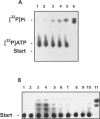Formation of different abzymes in autoimmune-prone MRL-lpr/lpr mice is associated with changes in colony formation of haematopoietic progenitors
- PMID: 17635644
- PMCID: PMC3922359
- DOI: 10.1111/j.1582-4934.2007.00048.x
Formation of different abzymes in autoimmune-prone MRL-lpr/lpr mice is associated with changes in colony formation of haematopoietic progenitors
Abstract
It was shown that IgGs from the sera of 2-7-month-old control non-autoimmune (CBA x C57BL)F1 and BALB/c mice and 2-3-month-old autoimmune prone MRL-lpr/lpr mice (conditionally healthy mice) are catalytically inactive. During spontaneous development of deep systemic lupus erythematosus (SLE)-like pathology a specific reorganization of immune system of these mice leads to conditions associated with a production of IgGs hydrolyzing DNA, ATP and polysaccharides with low catalytic activities (conditionally pre-diseased mice).A significant increase in DNase, ATPase and amylase IgG relative activities associated with a transition from pre-diseased to deep diseased mice is correlated with additional changes in differentiation and proliferation of mice bone marrow haematopoietic stem cells (HSCs) and lymphocyte proliferation in different organs. The highest increase in all abzyme activities was found in mice immunized with DNA, which in comparison with pre-diseased and diseased mice are characterized by a different profile of HSC differentiation and by a suppression of cell apoptosis. Abzyme activities in the serum of pregnant females were comparable with those for pre-diseased mice, but the profile of HSC differentiation and cell apoptosis levels in pregnant and pre-diseased mice were quite different. Right after the beginning of lactation (4 days after delivery) and in a late time of lactation (14 days after delivery) there was an observed increase in cell apoptosis and two different stages of significant change in the HSC differentiation profiles; the first stage was accompanied with a significant increase and the second with a remarkable decrease in abzyme activities. Overall, all mouse groups investigated are characterized by a specific relationship between abzyme activities, HSC differentiation profiles, levels of lymphocyte proliferation, and cell apoptosis in different organs. From our point of view, the appearance of ATPase, DNase activities may be considered the earliest statistically significant marker of mouse spontaneous SLE and a further significant increase in their activities correlates with the appearance of SLE visible markers and with an increase in concentrations of anti-DNA Abs and urine protein. However, development of autoimmune (AI)-reactions and the increase in the sera anti-DNA antibodies (Abs) and in the abzyme activities in pregnant and lactating mice do not associate with SLE visible markers and proteinuria. The possible differences in immune system reorganizations during pre-disease, disease, pregnancy and lactation leading to production of different auto-antibodies and abzymes are discussed.
Figures


Similar articles
-
DNA-hydrolyzing antibodies from sera of autoimmune-prone MRL/MpJ-lpr mice.Biochemistry (Mosc). 2003 Oct;68(10):1081-8. doi: 10.1023/a:1026350426842. Biochemistry (Mosc). 2003. PMID: 14616078
-
Changes in different parameters, lymphocyte proliferation and hematopoietic progenitor colony formation in EAE mice treated with myelin oligodendrocyte glycoprotein.J Cell Mol Med. 2016 Jan;20(1):81-94. doi: 10.1111/jcmm.12704. Epub 2015 Oct 23. J Cell Mol Med. 2016. PMID: 26493273 Free PMC article.
-
Changes in haematopoietic progenitor colony differentiation and proliferation and the production of different abzymes in EAE mice treated with DNA.J Cell Mol Med. 2017 Dec;21(12):3795-3809. doi: 10.1111/jcmm.13289. Epub 2017 Aug 5. J Cell Mol Med. 2017. PMID: 28780774 Free PMC article.
-
Immune Response and Production of Abzymes in Patients with Autoimmune and Neurodegenerative Diseases.Biochemistry (Mosc). 2025 Jan;90(Suppl 1):S373-S400. doi: 10.1134/S0006297924604167. Biochemistry (Mosc). 2025. PMID: 40164167 Review.
-
Natural catalytic antibodies in norm, autoimmune, viral, and bacterial diseases.ScientificWorldJournal. 2010 Jun 29;10:1203-33. doi: 10.1100/tsw.2010.98. ScientificWorldJournal. 2010. PMID: 20602079 Free PMC article. Review.
Cited by
-
Cellular and Immunological Analysis of 2D2/Th Hybrid Mice Prone to Experimental Autoimmune Encephalomyelitis in Comparison with 2D2 and Th Lines.Int J Mol Sci. 2024 Sep 13;25(18):9900. doi: 10.3390/ijms25189900. Int J Mol Sci. 2024. PMID: 39337388 Free PMC article.
-
Immunoglobulins with Non-Canonical Functions in Inflammatory and Autoimmune Disease States.Int J Mol Sci. 2020 Jul 29;21(15):5392. doi: 10.3390/ijms21155392. Int J Mol Sci. 2020. PMID: 32751323 Free PMC article.
-
Autoantibody-Abzymes with Catalase Activity in Experimental Autoimmune Encephalomyelitis Mice.Molecules. 2023 Jan 30;28(3):1330. doi: 10.3390/molecules28031330. Molecules. 2023. PMID: 36770997 Free PMC article.
-
Cell Differentiation and Proliferation in the Bone Marrow and Other Organs of 2D2 Mice during Spontaneous Development of EAE Leading to the Production of Abzymes.Molecules. 2022 Mar 28;27(7):2195. doi: 10.3390/molecules27072195. Molecules. 2022. PMID: 35408594 Free PMC article.
-
Catalase activity of IgG antibodies from the sera of healthy donors and patients with schizophrenia.PLoS One. 2017 Sep 25;12(9):e0183867. doi: 10.1371/journal.pone.0183867. eCollection 2017. PLoS One. 2017. PMID: 28945759 Free PMC article.
References
-
- Keinan EE, editor. Catalytic antibodies. Weinheim: Wiley-VCH Verlag GmbH and Co. KgaA; 2005. pp. 1–586.
-
- Nevinsky GA, Buneva VN. Human catalytic RNA-and DNA-hydrolysing antibodies. J Immunol Methods. 2002;269:235–45. - PubMed
-
- Nevinsky GA, Favorova OO, Buneva VN. Natural Catalytic Antibodies – New Characters in the Protein Repertoire. In: Golemis E, editor. Protein-protein interactions; a molecular cloning manual. New York: Cold Spring Harbor: Cold Spring Harbor Lab. Press; 2002. pp. 523–34.
-
- Nevinsky GA, Buneva VN. Natural catalytic antibodies-abzymes. In: Keinan E, editor. Catalytic antibodies. Weinheim: Wiley-VCH Verlag GmbH and Co. KgaA; 2005. pp. 503–67.
Publication types
MeSH terms
Substances
LinkOut - more resources
Full Text Sources
Medical

